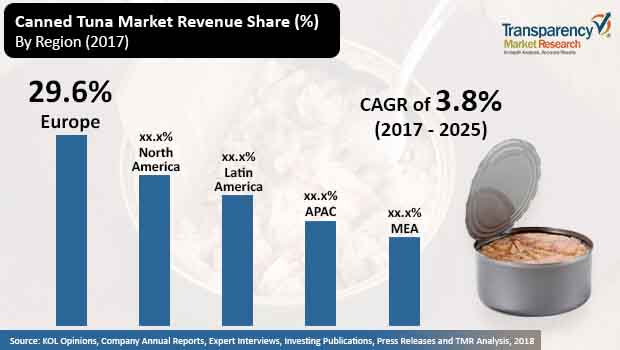Impact Assessment of COVID-19 Outbreak on Canned Tuna Market
Canned Tuna Market - Snapshot
Canned fish refers to those fish products that are processed and then sealed into an airtight container, such as tin containers and then it is subjected to heat. Canning refers to a procedure of food preservation and offers a shelf life of around one to five years. Fish comes with low level of acidity and at this level microbes can flourish. The growth of the global canned tuna market is likely to be shaped by the increased sales of the product at various channels of sales, both online and offline.
Five types of commercial tuna species are available in the market. Those types are as follows
- Skipjack Tuna
- Albacore Tuna
- Bigeye Tuna
- Yellowfin Tuna
- Bluefin Tuna
Enquiry Before Buying:https://www.transparencymarketresearch.com/sample/sample.php?flag=EB&rep_id=18581
Increased Sales through Supermarkets and Foodservice Outlets to Boost Demand
The canned tuna products are increasingly being sold at various foodservice outlets and supermarkets, which is likely to amplify growth prospects of the global canned tuna market in the years to come. Canned tuna finds increased use in tuna sandwiches or delis, thereby driving the demand for the product. Most of these canned tuna are either a mix of yellowfin tuna and skipjack or albacore. Small amounts of yellowfin tuna and significant amount of skipjack make up “Light tuna”, which is an economically priced product and accounts for a large chunk of the global canned tuna market. This product is an immensely popular canned product in the US and account for most of the canned tuna sales in the US.
So far, the only species authorized to be labeled “white meat tuna” in the US is Albacore tuna. Canned tuna is a rich source of various essential nutrients, such as Vitamin D, selenium, high quality protein, and omega-3 fatty acids. Plentiful presence of so many nutrients is likely to propel growth of the global canned tuna market in the forthcoming years.
Buy Now :https://www.transparencymarketresearch.com/checkout.php?rep_id=18581<ype=S
Although lifestyles of consumers worldwide are getting busier and faster, and the market offers an extensive range of prepared and frozen food, the global market for canned tuna is projected to experience passive growth over the next few years. Growing consumer dependency on prepared and ready-to-eat food is considered to be a key driver to push the demand for canned tuna a little farther over 2017-2025. Global revenue of canned tuna market was around US$ 10,496.1 Mn in 2017, which is expected to increase at a CAGR of 3.8% over the forecast period, reaching a value worth US$ 14,125.5 Mn by the end of 2025.

Explore Transparency Market Research’s award-winning coverage of the global Industry:https://www.prnewswire.com/news-releases/chp-combined-heat-and-power-installation-market-to-expand-with-advancements-in-thermal-energy-management-tmr-301196709.html
Drivers & Restraints:
While consumer demand for canned tuna witnesses a downward trend, the increasing demand from the Middle East is leveling off this decline, and emerging as an attractive market for ASEAN canned tuna exporters. The exemption from import duties in the Middle East has led to higher exports in this region. Egypt, Saudi Arabia, and Israel are the largest importers of tuna in the Middle East, accounting for 21%, 19%, and 11% import share, respectively. The import tariff in most of the countries in this region is only 5%, which is very low as compared to the U.S. and the EU. In spite of the large scope for fishing, the Middle Eastern region is poorly developed in fishing, and is thus heavily dependent on imports from ASEAN countries, especially Vietnam.
Market Taxonomy:
By species type, the global canned tuna market is segmented as albacore, skipjack tuna, yellowfin tuna, Bluefin tuna, bigeye tuna, and longtail tuna. By distribution channel, the market is segmented as direct and indirect. Furthermore, by indirect channel, the market is segmented as hypermarkets/supermarkets, specialty stores, online channels, convenience stores, and others. By end use, the market is segmented as foodservice and households.
About Us :
Transparency Market Research is a global market intelligence company, providing global business information reports and services. Our exclusive blend of quantitative forecasting and trends analysis provides forward-looking insight for thousands of decision makers. Our experienced team of Analysts, Researchers, and Consultants, use proprietary data sources and various tools and techniques to gather, and analyze information.
Our data repository is continuously updated and revised by a team of research experts, so that it always reflects the latest trends and information. With a broad research and analysis capability, Transparency Market Research employs rigorous primary and secondary research techniques in developing distinctive data sets and research material for business reports.
Comments
Post a Comment